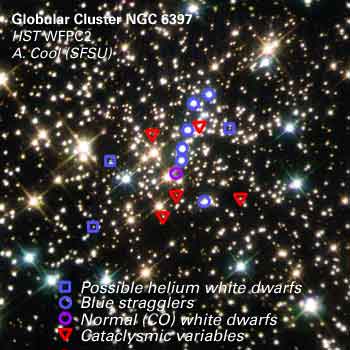Star Clusters
A star cluster is a group of stars that share a common origin and are gravitationally bound for some length of time. They are are particularly useful to astronomers as they provide a way to study and model stellar evolution and ages. The two basic categories of stellar clusters are open clusters, also known as galactic clusters, and globular clusters.
Open (Galactic) Clusters
Open clusters are so-named due to the fact that the individual component stars are easily resolved through a telescope. Some examples such as the Hyades and Pleiades are so close that the individual stars can be clearly distinguished by the naked eye. They are sometimes called galactic clusters due to their location on the dusty spiral arms on the plane of spiral galaxies. Stars in an open cluster have a common origin - they formed from the same initial giant molecular cloud. Clusters typically contain a few hundred stars though this can vary from as low as a few dozen up to a few thousand.
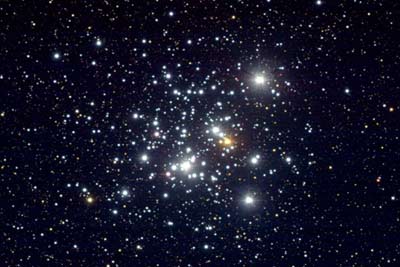
Stars within an open cluster are only loosely bound by gravity. As the cluster rotates around the galaxy it eventually disperses due to gravitational perturbations with other other objects in the galaxy. Whilst our Sun is likely to have initially formed in an open cluster there is now no discernable clustering with nearby stars. Open clusters are therefore usually relatively young objects. Some, such as the Pleiades still show evidence of nebulosity suggesting their recent formation. Open cluster stars belong to Population I, they are young and have high metallicities. Clusters range from a couple to 20 or so parsecs across.
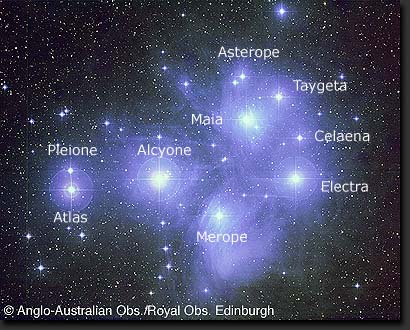
Globular Clusters
Globular clusters contain several thousand to one million stars in spherical, gravitationally-bound system. Located mostly in the halo surrounding the galactic plane they comprise the oldest stars in the galaxy. These Population II stars are highly evolved but with low metallicities. Clusters are so old that any star higher than a G or F-class will have already evolved off the main sequence. There is little free dust or gas found in globular clusters so no new star formation is taking place in them. Stellar densities within the inner regions of a globular cluster are very high compared with regions such as those around the Sun.
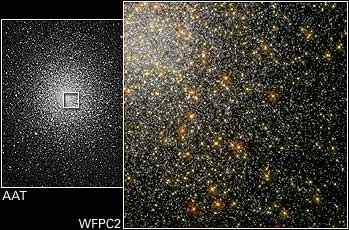
As with open clusters, stars in globular clusters probably had a common origin. Unlike open clusters, globular clusters normally remain gravitationally coherent throughout their lives. The stars within them are not dispersed out of the cluster. Our Milky Way has about 200 globular clusters. Prominent examples include 47 Tuc, M4 and Omega Centauri although there is some debate as to whether this may in fact be a captured dwarf spheroidal galaxy.
Cluster Ages and Zero-Age Main Sequence
Star clusters are particularly important because they allow astronomers to check models of stellar evolution and the ages of stars. Let us look firstly at open clusters to understand why this is so.
Stars in an open cluster have a common origin from a given nebula. They therefore share the same initial metallicity so any effect of this on stellar evolution is effectively the same for the members of the cluster. Another important point is that all stars within a cluster are effectively at the same distance form an observer on Earth. Even though a cluster may be a few parsecs across this size is insignificant compared with the much greater distance of the cluster from Earth. If we take photometric readings for the cluster stars, the apparent magnitude of each thus also allows us to infer the relative absolute luminosities of the cluster members. The stars that appear brightest within a cluster are intrinsically more luminous than fainter members.
Astronomers use this fact to obtain a colour-magnitude diagram for a cluster. This is simply an HR diagram that plots apparent magnitude, usually V (or mV) on the vertical axis against colour index, B - V on the horizontal. Using spectroscopic parallax they can then calibrate the diagram to obtain values for absolute magnitude, M or MV. By doing this for several open clusters we find an interesting result. The images below show some open clusters. On the left we have h + χ Persei, a double open cluster in which the two clusters, 2,200 parsecs distant are only separated by about 30 parsecs. The right-hand image shows M67. Do you notice any differences between the two images?
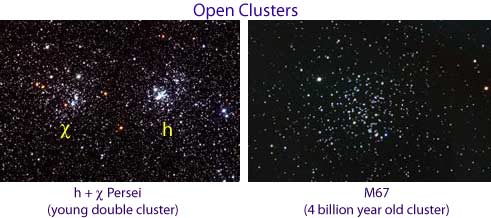
If we plot these open clusters and others on an HR diagram we would get the plot below. As clusters are at different distances it has been calibrated to absolute magnitude.
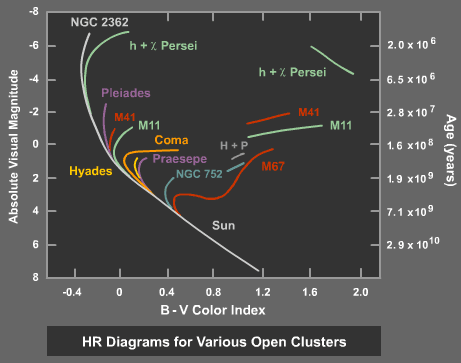
If you study this diagram closely you will notice a new scale on the right-hand vertical axis. The "years" here refers to the age of the cluster. A cluster such as h + χ Persei is so young that most of its stars are still on the main sequence - they have not yet turned-off. The Pleiades, being slightly older, has no stars hotter than colour index 0 (A0 spectral class) left on the main sequence. The more massive cluster members have already evolved off the main sequence to the giant branches. M67, a very old open cluster has no star hotter than +0.4 colour index left on the main sequence. Of key importance is the turnoff point on the diagram where the cluster turns-off the main sequence. The further down the main sequence the turnoff point is, the older the cluster.
When a star first achieves core hydrogen fusion and appears on the main sequence it is said to be zero-age. The zero-age main sequence (ZAMS) is the main sequence of all the stars when they initially form in a cluster. The higher up the main sequence, the more massive the star is.
As globular clusters are generally much older than open clusters their colour-magnitude diagrams show more evolved stars. They also have no high-mass stars left on the main sequence. The colour-magnitude diagram below for M55 illustrates this point.
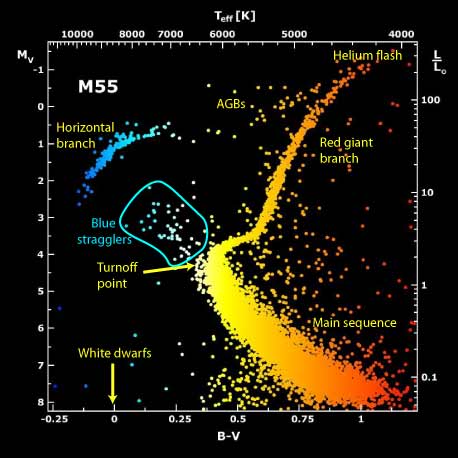
Interestingly, if you study the diagram above you see a group of hot stars that appear to be on the main sequence above the turnoff point. These are in fact known as blue stragglers. Due to the high stellar densities within globular clusters astronomers believe that some stars can coalesce and merge together. The combined mass therefore makes the new star hotter (bluer) and brighter than the bulk of the stars.

